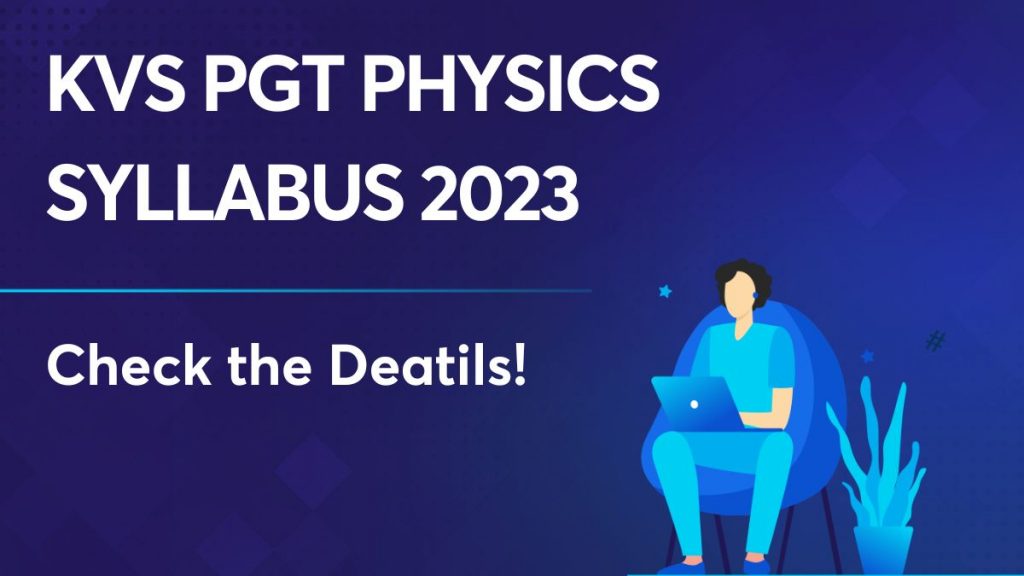Kendriya Vidyalaya Sangathan has published the KVS PGT Syllabus 2023. The KVS PGT 2023 notice has already been issued. To pass the KVS PGT Exam, applicants must have a thorough comprehension of the subject. Candidates can improve their performance in the next test by familiarising themselves with the KVS PGT curriculum. They must go through all of the study material for each subject. We have discussed the complete KVS PGT Physics Syllabus 2023, test pattern, marking scheme, and other important facts regarding the KVS PGT Exam 2022 in this post.
KVS Syllabus For PGT Physics: Important Facts
Applicants who have begun studying for the KVS PGT exam are seeking a suitable KVS PGT Syllabus Physics. We have compiled some information about the KVS PGT Physics Syllabus 2023 in this part. In addition, for the convenience of the applicant, we will give a direct link beneath this table. Simply click on it to obtain the KVS PGT Physics Syllabus 2023 PDF. The specifics are as follows:
|
Organization Name |
Kendriya Vidyalaya Sangathan |
|
Recruitment |
KVS PGT Recruitment 2022 |
|
Name of the Post |
Post Graduate Teacher (PGT) |
|
Category |
Syllabus |
|
Exam Level |
Central level Exam |
|
Selection Process |
Written Exam and Interview |
|
Mode of Exam |
Online (Computer Based Test) |
|
Official Website |
Download KVS PGT Physics Syllabus PDF Here!
Syllabus For PGT Physics
In this section, we will discuss the detailed Syllabus For PGT Physics. Applicants can check it out to get an idea for the upcoming KVS exam.
|
UNITS |
TOPICS |
|
Unit 1: Physical World and Measurement |
|
|
Unit 2: Kinematics |
|
|
Unit 3: Laws of Motion |
|
|
Unit 5: Motion of System of Particles and Rigid Body |
|
|
Unit 6: Gravitation |
|
|
Unit 7: Properties of Bulk Matter |
|
|
Unit 8: Thermodynamics |
|
|
Unit 9: Oscillations and Waves |
|
|
Unit 10: Electrostatics |
|
|
Unit 11: Current Electricity |
|
|
Unit 12: Magnetic Effects of Current and Magnetism |
|
|
Unit 13: Electromagnetic inductions and Alternating Currents |
|
|
Unit 14: Optics |
|
|
Unit 15: Modern Physics |
|
|
Unit 16: Electronic Devices |
|
How to Download the Syllabus of PGT Physics In KVS
The KVS Exam Part II covers a wide range of topics, including Physics. As a result, in this area, we will teach you how to get the KVS PGT Physics Syllabus curriculum. Candidates are encouraged to obtain the PGT Physics KVS Syllabus by following the instructions outlined below.
Step 1: Go to the KVS website at www.kvsangathan.nic.in.
Step 2: Go to your home page and look for the KVS PGT notification link.
Step 3: Select the link.
Step 4: Carefully read the curriculum information in the announcement.
Step 5: Download it or print a clear copy for future reference.
One thing to keep in mind for applicants is that when you download the KVS PGT curriculum from the official website, you will obtain the syllabus for all relevant topics. For your convenience, we have included a direct link to the KVS PGT Physics Syllabus 2023 PDF on this page. Simply click on it to get the KVS test syllabus for PGT Physics.
KVS PGT Exam Pattern 2023
Let’s observe the KVS PGT Exam Pattern 2023. It will provide you with an understanding of the paper pattern and scoring system. Check out the following vital details:
|
Test |
Subjects |
Number of Marks |
Number of Questions |
Exam duration |
|
Part I |
General English |
10 |
10 |
2 hours and 30 minutes |
|
General Hindi |
10 |
10 |
||
|
Part II |
General knowledge & Current Affairs |
10 |
10 |
|
|
Computer Literacy |
10 |
10 |
||
|
Reasoning Ability |
10 |
10 |
||
|
Pedagogy |
20 |
20 |
||
|
Subject Concerned |
80 |
80 |
||
|
Total |
150 |
150 |
||
KVS PGT Physics Syllabus 2023: FAQs
Part 1 and Part 2 are divided into two portions. Each section contains distinct things to study for this exam.
We have provided the entire KVS PGT Physics Syllabus 2023 along with the pdf for the syllabus KVS PGT Physics in this article. You may look it up to learn more about it.
We can download the KVS PGT Physics Syllabus 2023 from the official website or by the direct link provided in the article
A total of 150 questions are there in the KVS PGT Exam.
No, there will be no negative marking in this exam.
